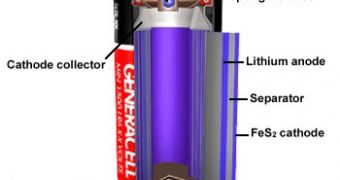The biggest drawback of most portable electronic devices, such as notebooks, cellphones, PDAs and many others is the fact that they become useless after the rechargeable batteries completely discharge.
Unfortunately, the devices themselves have known huge developments, while their batteries remain a source of discontent among users. Even the most advanced laptop can only last for three hours if relying only on the most advanced lithium batteries.
Now, researchers at the Department of Energy's Argonne National Laboratory have developed a new approach to increasing the capacity and stability of rechargeable lithium-ion batteries.
It's based on a new material that the positive electrode will be made of. The material itself has a multi-layered nano-crystalline composite structure.
The new approach of the Argonne laboratories focused on a two-component structure, an active component responsible for the charge storage that is embedded in another, inactive component that has a stabilizing role in the structure.
The first tests are promising, as the new composite materials showed exceptionally high charge-storage capacities, in excess of 250 mAh/g, which is more than twice the capacity of materials in conventional rechargeable lithium batteries.
Furthermore, the stability of the new batteries has also increased, even though few people know that conventional lithium batteries can be dangerous if mistreated and unless care is taken their lifespan may be reduced.
For now, the most advanced lithium-ion battery design is the lithium polymer cell.
Another advantage of the new technology is that the overall cost of the lithium batteries will be lowered by focusing on manganese-rich systems, instead of the more expensive cobalt and nickel versions.
Here's another thing that most consumers don't know and that the producers don't ever mention: the lifespan of the lithium-ion battery depends largely on the manufacturing time (shelf life) regardless of whether it was charged and not just on the number of charge/discharge cycles.
In other words, if you buy a new Li-ion battery that has been produced in the same lot as your used battery and has never been used, the unused one, (that stayed on a shelf for the same period of time when you were using yours), is, in fact, not much better than your old one!

 14 DAY TRIAL //
14 DAY TRIAL //